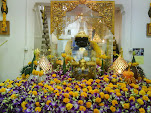Supported by his fellow monks, Luang Phoo, 101 years old, stands before his congregation.
He has been dead for 13 years.
Wat Krang Chu Si Charoensuk is located near Singburi, a provincial town in central Thailand, a couple of hours north of Bangkok. Born in 1894 in Lopburi and ordained in 1922, the revered monk acted as abbot for several monasteries, surviving wars, civil conflict, dictatorships and military coups. His charisma brought people to the temple. Under the guidance of Luang Phoo, life at Wat Krang Chu Si Charoensuk blossomed.
Nowadays, Luang Phoo rests in a glass coffin within the wat's prayer hall. On his birthday, he is lifted from his slumber, cleansed and paraded in front of the ever-shrinking congregation.
Once Luang Phoo has been extracted from the glass coffin Everyone pushes to the front to pay their respects. Camera flashes illuminate the scene while the monks undress the dead abbot and put a new orange robe on him. A woolly hat is pulled over Luang Phoo's bald skull. A second hat is pushed on top. Even his socks are changed. Finally, the crowd pushes in, tiny flakes of gold in their hands
Finally, the other monks pick up Luang Phoo as gingerly as possible and maneuver him back towards his coffin. Eventually, the monks manage to return the corpse to its repository with sufficient dignity.
Incredibly, the abbot does not decompose. His body has mummified, allegedly because Luang Phoo dehydrated himself on his deathbed. It is believed that a monk who does not decompose following his death should be preserved and worshipped. Often, local authorities disagree and there have been conflicts over whether to burn some monks' remains or keep them in a glass coffin, as at Krang Chu Si Charoensuk.
Monday, 26 May 2008
Subscribe to:
Post Comments (Atom)


No comments:
Post a Comment